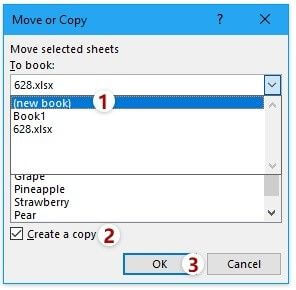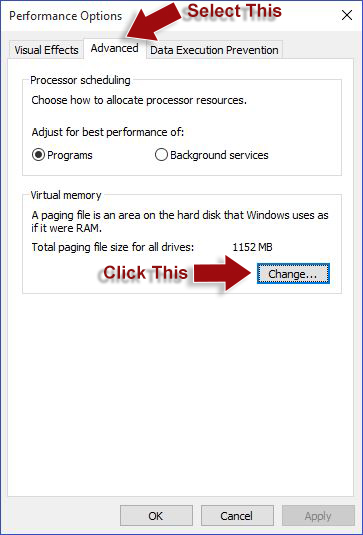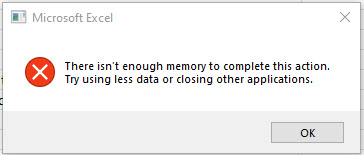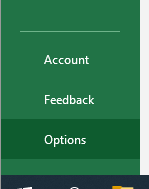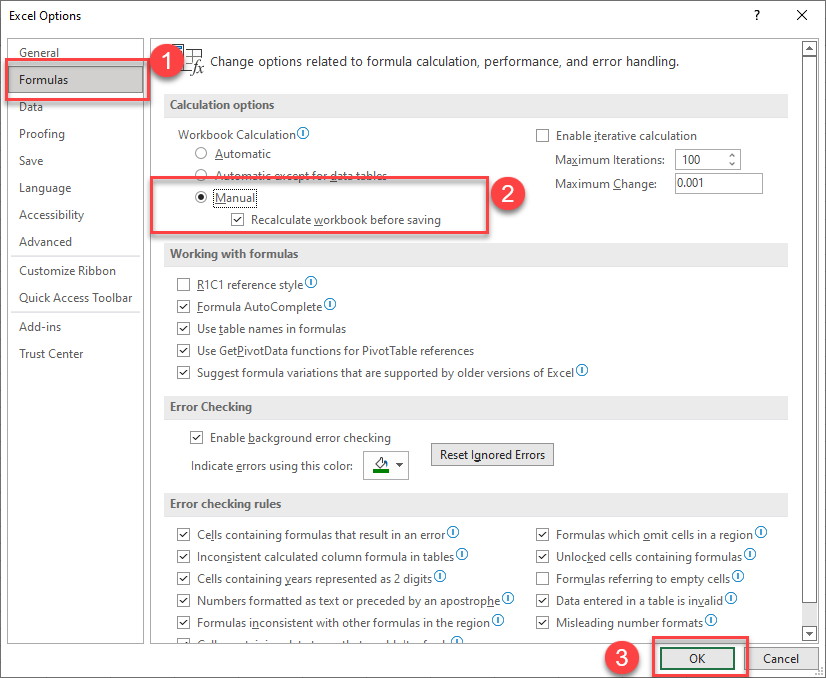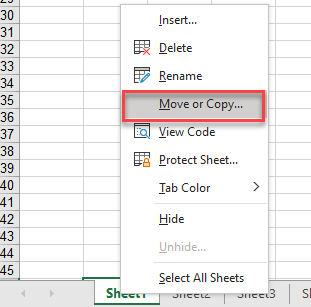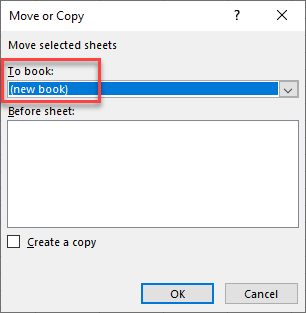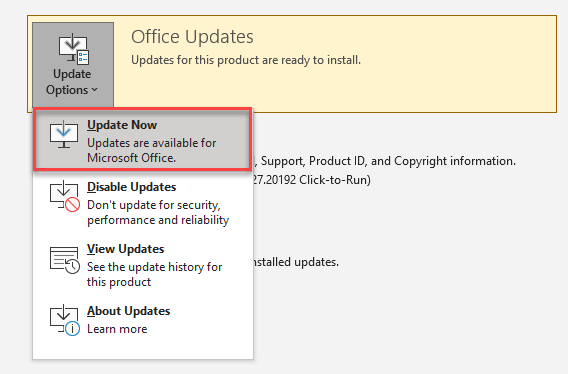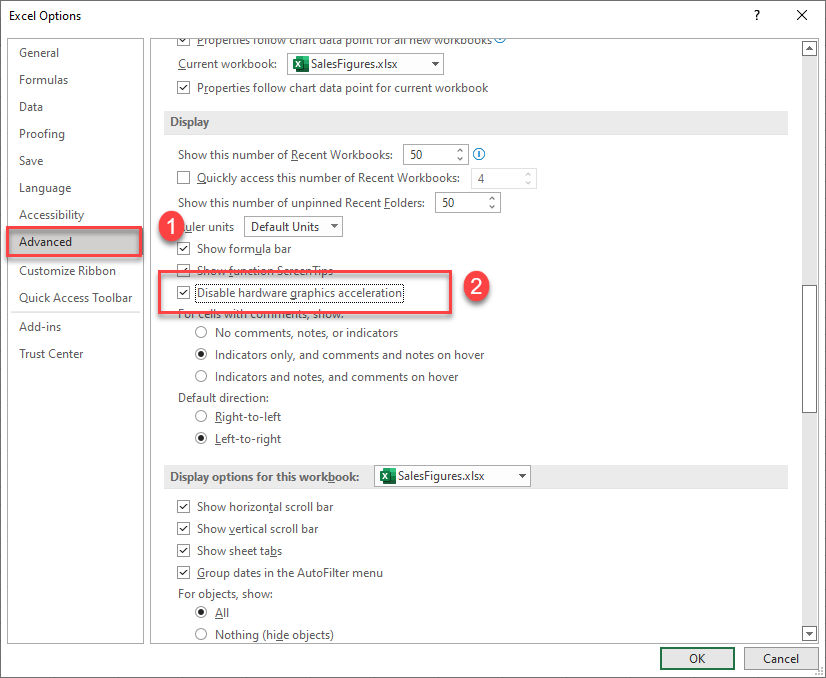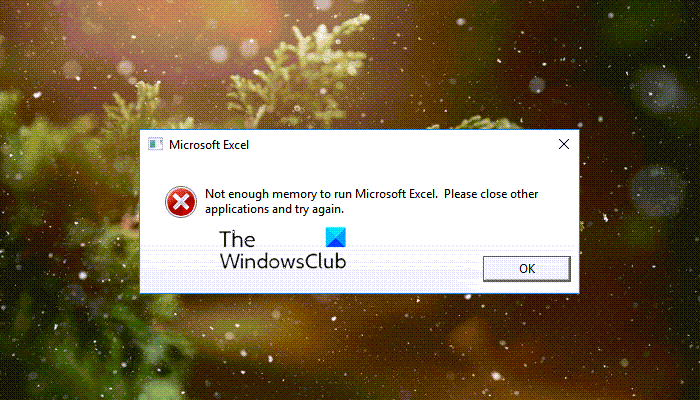Memory issues are very common while dealing with the Microsoft Excel application. No matter what MS Excel version you are using memory errors is not bounded to any specific versions.
There are different types of Excel memory error occurs that prevent the user to execute a specific action.
In this blog, we will discuss those Excel not enough memory errors and try different solutions to get rid of them.
But before going to troubleshoot Excel out of memory error, it is recommended to find out the root cause of this error. As this will help you to prevent any type of Excel there isn’t enough memory to complete this action error from letting happened in the future again.
Why Does Excel Say I Don’t Have Enough Memory?
Following are the causes of Excel Not Enough Memory error :
1. Copying Formulas to Large Area
It’s obvious to encounter Excel insufficient memory error if you are trying to copy the formula to large area of your worksheet. Excel 32 bit versions have a limit of 2 GB thus working with a large worksheet section leads to generate this error.
2. Formula Re-Calculations
Such a type of memory error also arises due to the recalculation of formulas mainly when you insert any columns/rows, copy-paste, or while performing any calculations.
Suppose, your excel workbook contains thousands of formulas on the sheet and you have just added one more column into it. In that case, Excel has to recalculate the entire formula of your worksheet for adjusting this newly added column.
All in all Excel out of resource error also depends on the complexity of your spreadsheet such as what formulas are involved in it or how your spreadsheet is built.
3. Other Problem Causing Elements Of The Spreadsheet
Even though your PC is having enough space in the local memory but you get there isn’t enough memory to complete this action excel error due to the presence of complex pivot tables, macros, complex charts in the workbook.
4. Other Heavy Applications Are Holding Up The Memory Space
Another reason can be the execution of heavy-size applications on your PC that has already captured a huge amount of your PC’s memory space. Thus excel is not getting enough memory to work with.
Now, coming to the point, let’s start solving different memory errors one by one:
How To Fix There Isn’t Enough Memory To Complete This Action Excel Error?
Method 1# Fix Corrupt Excel File
Sometimes such an error also arises due to Excel file corruption. So in that case always look for reliable tools like Excel repair tool.
- This tool is very much efficient to resolve any type of corruption, error, and issues that occurred in your Excel workbook.
- With this unique tool, you can repair multiple Excel files in just one go and easily recovers entire data in your desired location.
- It is very easy to use and quite compatible with both Windows as well as Mac OS.
- Well, support for Excel entire versions.
- Before making the purchase you can try the demo version of this tool, it’s free of cost.
* Free version of the product only previews recoverable data.
Method 2# Lack of PC Memory
It is seen that many cheaper PCs are having only 1 to 2 GB of memory space. Well, it’s enough for browsing the internet and many more tasks but not fits under these circumstances.
- If you are using Windows 7 or XP 32 bit version PC then you need to use the 4GB memory space.
- Users of Windows 7 or Windows 10 64 bit version need to buy extra memory.
After launching Microsoft Excel 2016, Microsoft is pressurizing the users to install 64-bit Office in order to skip the running out of memory and resource issues. In their previous version of Excel, Microsoft suggested 32-bit because some of the controls and add-ins were not yet present in the 64-bit compatible versions. If you are dealing with a lot of macros then it is recommended to test it first before migrating to 64-bit Excel.
Method 3# Separate Excel File Into Different Workbooks
Split the large size Excel file into separate workbooks as this will avoid the complexity of handling Excel large files.
By implementing this trick you can easily avoid the restriction of using 2GB memory space on Excel files.
Here are the steps which you need to follow:
- Select the sheet from your workbook sheets tab. Make a right-click over the sheet and then from the menu choose the “Move or Copy”
- By pressing the “Ctrl” key you can select several other non-adjacent sheets.
2) From the opened window of “Move or Copy“, choose the “(new book)” option which is present under the list of “To book”. Also, choose the option of “Create a copy” and then click the “OK” button.
3) Your chosen worksheets are now shifted to a fresh new workbook. Hit the “File” tab and choose the “Save” option to save new excel.
Method 4# Switch To Manual Calculation Method
To solve Excel out of memory error you need to stop the Excel application for recalculating the complete data after any changes.
To set manual calculation to your Excel workbook, you need to follow down these steps:
1) Go to the “File” tab from the Excel ribbon
2) From the list of appearing menus choose the “Options”.
3) This will open the Excel Options window; here you have to choose the “Formulas” tab from the left pane.
4) Hit the Manual option which is present under the section of the calculation option. Here you will see an option “Recalculate workbook before saving” if you keep this option enabled then each time before saving the workbook, complete data is recalculated.
Besides this, you can also approach the faster method of worksheet’s manual recalculation.
1) Follow this path: Formulas >Calculations Options> Manual
3) You can also press the “Calculate Sheet” options present in the Calculation section. Or just free the “Shift” and “F9” key together from your keyboard. This will perform a quick calculation over the data of your current worksheet.
Different Types Of Excel Memory Error Alongwith Their Fixes:
Error 1# Getting “Not Enough Memory” Error Messages While Trying To Copy Formulas Over Large Area In Excel
You will receive “Not Enough Memory” Error messages when you try to fill or copy formulas into a large area of a worksheet. This error message may also appear when you try to add formulas to a large worksheet. In both instances, you will receive the same error message saying that:
Not enough memory.
Not enough system resources to display completely.
Why This Error Is Triggering?
As we already discussed that each of the Microsoft Excel versions such as Microsoft Excel 2007, Excel 2010, and Excel 2013 32-bit is set to 2 GB of memory which is also called the internal heap space. Along with the memory, each of the instances is also set to the 32,760 source cells to do a smart fill operation. When you try to copy the large sections of a worksheet, then due to these limitations you will get the memory error.
How To Solve This Error?
In order to solve this issue, follow the given steps carefully:
Step 1: Try to fill only the part of the range that you want to fill.
Step 2: Choose only the end row or last two rows of the filled choice, and then paste beyond down the sheet.
Step 3: Now, you have to do again step 2 until you have filled the complete range that you want to fill.
In order to get rid of the memory limit, you should split your tasks into smaller workbooks, and try to open them in different instances of Microsoft Excel.
Error 2# Microsoft OFFICE 2016- There Isn’t Enough Memory To Complete This Action
This issue generally appears while trying to erase one single row in an Excel sheet. It throws an error message: there isn’t enough memory to complete this action Excel and after that, the application freezes up.
The cause behind this issue is not clear, but you can solve this issue with ease. Follow the below-given steps one by one to get rid of this problem:
- First of all, confirm that all of your system drivers are updated. Also, update the Microsoft Office. To do this go through the, File> Account> Office Update> Update Now.
- After it, you need to unmark ‘Disable hardware graphics acceleration’ by going through File>Option>Advanced>Display.
Now, check that the issue is gone or not.
Error 3# Microsoft Excel Cannot Open or Save Any More Documents Because there is Not Enough Available Memory or Disk Space
This error message is very irritating, as your computer or laptop have enough disk space in C or D drive and memory but Excel shows you don’t have enough memory available.
Generally, this error message appears on Excel files that contain complicated formulas, calculations, or external resources.
That’s why; the security settings in Microsoft Excel will stop opening these files and shows this irrelevant error message.
It is clear that this issue is related to the built-in security settings of Excel 2013 or 2016. Follow the given steps to get rid of this issue:
Step 1: First, you have to create a new Excel file and then navigate to the Options from File Menu.
Step 2: Click on the Trust Center Settings and under the Trust Center settings, uncheck all checkboxes in Protected.
Through this, you will help the Excel file to open without any security errors like “Microsoft Excel cannot open or save any more documents because there is not enough available memory or disk space”.
Once you press the OK and applied the settings then try to open the same Excel file which is showing the error.
Error 4# Unable To Open The Attachments In Excel Because Of The “There Isn’t Enough Memory Or Disk Space” Error
In order to get rid of this error and allow more memory, you have to exit from the workbooks or close the application that you don’t need. In order to free disk space, erase files that you don’t need.
If this issue is occurring with a particular file then it is sure that it is a file-specific issue.
- So, first, you have to find out the file format of the attached file. Try to save the file locally on your computer and then try to open the file.
- Right-click on the locally saved file and go to its Properties and unmark the Block option and then again try to open the file.
In case you are still unable to open the file in Microsoft Excel then you have to open the file in CSV file format. To do this, go to the save as option and save the file as a CSV format. After it, try to open the file and check for the issue.
Error 5# “Excel Has Ran Out Of Resources” Whilst Working On Microsoft Excel
This issue generally appears on 32 bit Excel, but sometimes also affects the 64 bit Excel.
To fix this issue you have to set your paging file size to automatic, follow the below-given steps:
- Navigate through the “Start-> Control Panel->Advanced System Settings.
- After that hit the Advanced->Performance> Settings->Advanced->Virtual Memory-> Change. Now, you have to mark the box for Automatically manage paging file size for all drives.
- At last, click on the OK buttons to close all Windows.
Conclusion
After applying the above-given solutions your problem of Excel not enough memory error will easily get resolved. All the given solutions are very simple to apply so you don’t have to call any professional or invest a single penny for it.
But, if you are encountering any other Excel memory error apart from the errors I have listed above. In that case, share your problems with us by commenting on this blog.
Priyanka is an entrepreneur & content marketing expert. She writes tech blogs and has expertise in MS Office, Excel, and other tech subjects. Her distinctive art of presenting tech information in the easy-to-understand language is very impressive. When not writing, she loves unplanned travels.
One of the Excel error messages that disrupt the user’s workflow and aren’t so easy to resolve is the “Not Enough Memory” error. In this tutorial, I will tell you when this error usually occurs, will explain the possible causes behind it, and will give you some effective steps and solutions to fix it.
A- When does “Not Enough Memory” Excel error occurs
The “Not Enough Memory” Excel error can be shown in different message forms with almost the same meaning.
The error message can say:
- There isn’t enough memory to complete this action. Try using less data or closing other applications. To increase memory availability, consider:
- Using a 64-bit version of Microsoft Excel.
- Adding memory to your device.
or:
- Out of Memory.
or:
- Not enough System Resources to Display Completely.
or:
- Excel cannot complete this task with available resources. Choose less data or close other applications.
The “Not Enough Memory” Excel error can occur in the following situations; When:
- You open multiple large Excel workbooks.
- You open or close a large Excel workbook.
- You save large Excel workbooks.
- You work on large sheets with lots of formulas
- You sort a lot of data in a large Excel spreadsheet.
- You Copy and paste a lot of data in a large Excel spreadsheet.
- You fill formulas into a large range of cells.
- You run a complex Excel VBA project.
B- Causes of “Not Enough Memory” Excel error
Although the “Not Enough Memory” Excel error might seem to state the available memory as the problem, the root causes of this error are beyond the simple device memory amount and are more related to the bitness of your Excel version (32-bit or 64-bit), to the number of your open workbooks, to their content, and to the installed add-ins.
The causes of the “Not Enough Memory” Excel error can be:
- The number of open workbooks and their sheets.
- A big workbook in the 32-bit Excel edition.
- A large number of complex Excel features.
- Use of complex formulas that involve large data.
- Use of unnecessary large references in formulas.
- Interfering add-ins.
– The number of open workbooks and their sheets
The number of the Excel workbooks that you can open and the number of the spreadsheets in a workbook are limited by the available memory and the system resources as specified by Microsoft in its Excel specifications and limits. So, you might get the “Not Enough Memory” Excel error if you are working on a lot of workbooks and/or the open workbooks contain a huge number of spreadsheets.
– A big workbook in the 32-bit Excel edition
When working with big workbooks in the 32-bit Excel edition, you might get the “Not Enough Memory” Excel error; this is because the virtual address space allocated to Excel in the 32-bit edition is limited to 2GB that a workbook has to share with the Excel application itself and the installed add-ins. So, the size of a workbook in the 32-bit Excel edition should be much less than 2 GB to enable a flawless workflow, without hanging up or generating memory errors.
– Use of a large number of complex Excel features
The number of complex Excel features that can be used in a workbook is limited by the available memory and the system resources as specified by Microsoft in its Excel specifications and limits. Examples of these features limitations are the number of the names in a workbook, of the linked spreadsheets, of the scenarios, of the reports, of the charts linked to a spreadsheet, of PivotTable and PivotChart reports, and of the views on a shared workbook.
– Use of complex formulas that involve large data
If you’re getting the Excel memory error while trying to insert rows or columns, copying and pasting data, or calculating using formulas, most probably is that you’re including ranges of cells that are involved in calculation formulas, which forces Excel to automatically recalculate all involved formulas each time such actions are performed in order to match the new situation.
– Use of unnecessary large references in formulas
Out of laziness, we often tend to select entire columns or rows when setting references in our formulas, which add time to the recalculation period that occurs each time a change is made in the spreadsheet or workbook, and may consume a lot of memory depending on the number of columns and rows.
– Interfering add-ins
The activation and use of some add-ins might consume too much memory and causes the throw of Excel memory errors.
The “Not Enough Memory” Excel error would have many solutions depending on the sources of the error, that I listed in the above section.
So, to fix the “Not Enough Memory” Excel error, you should do one of the following, depending on your situation:
- Close other applications that consume memory.
- Break your large workbooks into smaller ones.
- Reduce the number of used complex features.
- Reduce the range of cells you’re using.
- Use adequate references in your formulas.
- Use Manual calculation instead of Automatic.
- Use Vlookup function instead of OFFSET.
- Use VLOOKUP instead of MATCH and INDEX.
- Disable Hardware Graphics Acceleration.
- Deactivate the suspect add-in.
- Update the 32-bit Excel 2013 or 2016.
- Upgrade Excel 32-bit to 64-bit edition.
- Add more memory to your device.
Let’s now dig deeper into each of the above solutions.
– Close other apps that may consume too much memory
Your computer memory may be not sufficient to load at the same time large Excel workbooks with complex features and formulas, and other applications, so, you mighty need to close these other programs to let enough memory to Excel.
The easiest way in Windows to check how much memory a program is consuming and freeing it up is by using Windows Task Manager:
Open Windows Task Manager using the Ctrl+Shift+Esc keyboard shortcut. In the process tab, click on the “Memory” header to sort the programs list by memory consumption; then, select the programs that you don’t need and that are consuming too much memory, and click on the “End Task” button.
The selected program will be closed, which will free up more memory to Excel and other applications you’re using.
– Break your large workbooks into smaller ones
To fix the Excel memory error when working with large workbooks, you’ll need to first break them into smaller ones. The simplest way to do is by checking your spreadsheets topics and moving the related ones to new workbooks.
– Reduce the number of used complex features
To fix the memory issue in Excel, try to reduce the number of the names in a workbook, of the linked spreadsheets, of the scenarios, of the reports; also try to reduce the number of or remove any unwanted charts linked to a spreadsheet, any PivotTable or PivotChart reports, or views on a shared workbook.
– Reduce the range of cells you’re using
When you’re working on a large range of cells, for example a copy or filling operation, and get the Excel memory error, you can just choose a smaller range and operate gradually until you complete your goal.
– Use adequate references in your formulas
In your formulas, try to reference only the ranges you need and not whole columns or rows.
– Use manual calculation instead of automatic
To prevent the automatic calculation of Excel formulas each time a change is applied that consumes a lot of memory when dealing with large data, change the automatic calculation to manual and apply it only when you need.
To change the calculation method of Excel from automatic to manual:
- Click on the Formulas tab.
- Go to the Calculation group of commands.
- Click on the Calculation Options drop-down list.
- Select “Manual”.

With this setup, Excel won’t automatically calculate formulas and you’ll need to do it manually when needed by going to the Calculation group of commands in the Formulas tab, then clicking on the “Calculate Now (F9)” command to calculate the entire workbook or the “Calculate Sheet (Shift F9)” command to calculate only the active worksheet.
– Instead of Offset, Use Vlookup or Match and Index
Using OFFSET function or a combination of MATCH and INDEX functions in your formulas can consume a lot of memory, especially when using references of whole columns or rows.
So, the best solution in this case is to instead use the VLOOKUP function that uses less memory in comparison.
– Disable Hardware Graphics Acceleration
Hardware graphics acceleration provides animations in the application; and disabling it may help in reducing memory consumption and preventing the memory issue message.
To disable hardware graphics acceleration in Excel:
- Click the File tab (Office button in Excel 2007).
- Click on Options at the bottom.
- Click on Advanced in the left pane.
- Go to the Display section in the right pane.
- Check Disable hardware graphics acceleration.
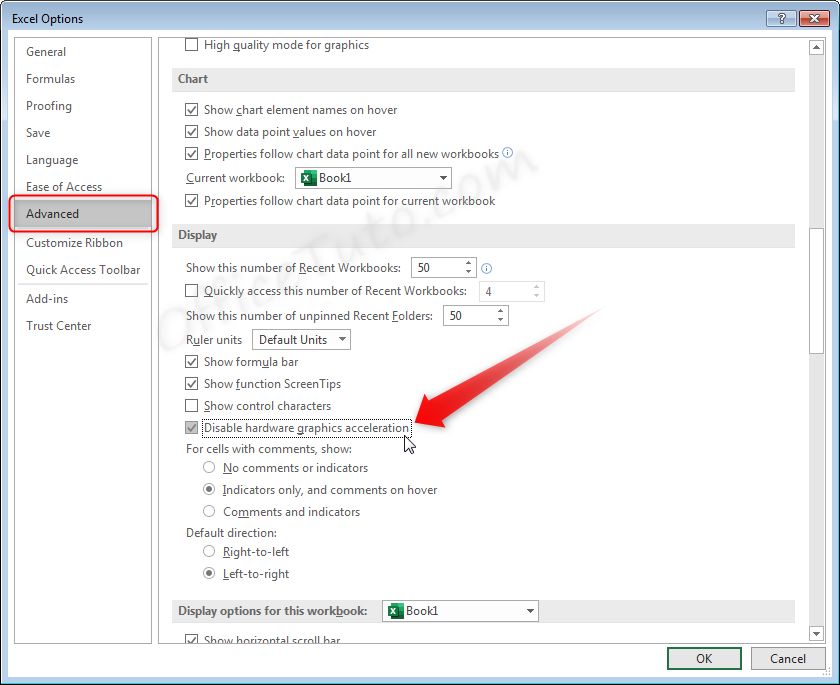
– Deactivate the suspect add-in
If the Excel memory error is shown each time you use a feature related to an add-in, try to disable it and see if it resolves the problem.
To disable an add-in in Excel:
- Click the “File” tab, then “Options”.
- Excel Options dialog box displays.
- In the left pane, click the “Add-ins” category.
- Next to “Manage”, select the category you want.
- Click on “Go”.
- Uncheck the add-in you want to deactivate.
- And click “OK”.
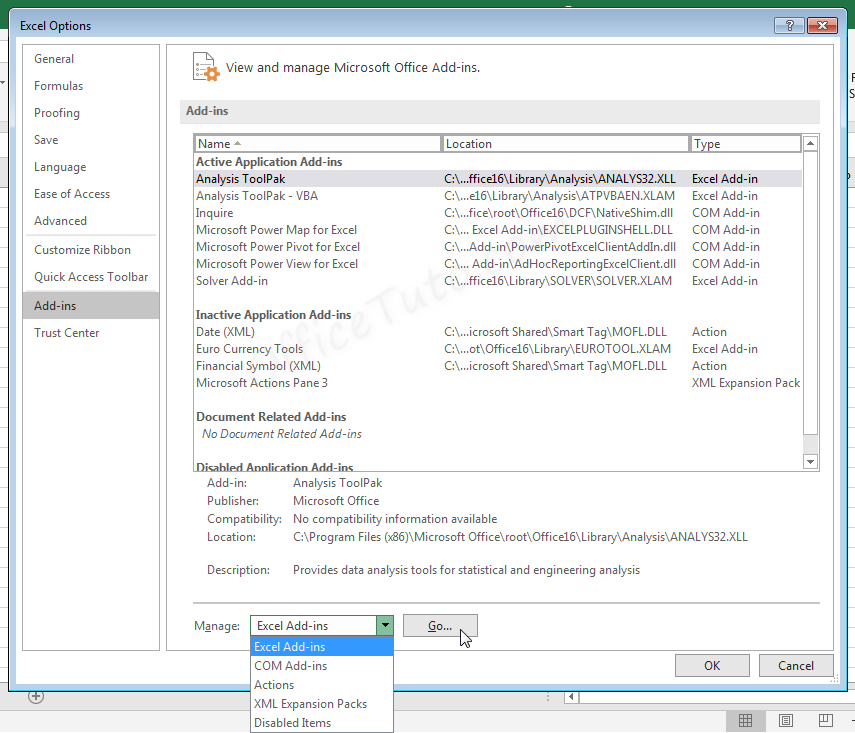
– Update the 32-bit Excel 2013 or 2016
If your Excel version is 2013 or 2016, Office 365 for 2013, or Office 365 for 2016, AND is a 32-bit edition, you should update Excel to benefit from the Large Address Aware capability that Microsoft provided in this particular situation to allow more memory than the 2GB limitation. See more on this functionality, along with the updates needed, on the Large Address Aware capability change for Excel.
So, with this update:
- On a 32-bit Windows, these Excel versions will have their memory space increased from 2GB to 3GB. This is not automatically done after the update, and you need to follow the instructions here to manually implement this increase.
- And on a 64-bit Windows, the Excel memory space will be increased from 2GB to 4GB. This is done automatically with the update and no further action is required.
– Upgrade Excel 32-bit to 64-bit edition
If you have enough memory on your device, meaning more than 4GB, and you’re working on big sized workbooks, check if your Excel version is a 32-bit edition. If it is, you should probably upgrade it to a 64-bit edition, as this edition doesn’t have the 2GB memory limitation that the 32-bit edition has.
– Add more memory to your device
As a final solution, and if you have only 2GB or 3GB of RAM, you’ll probably need to add more memory to your system. 4GB of RAM would be the minimum for your system to allow enough available memory to Excel and other running applications.
D- Conclusion
There are lots of causes to the Excel “Not Enough Memory” error and you need to choose your solution accordingly.
Depending on the situation, you’ll need to: just close other applications as a first workaround; break your large workbooks into smaller ones and reduce the range of used cells or the number of complex features; define adequate references in the formulas; carefully choose the functions you use; change some Excel settings; deactivate interfering add-ins; either update your Excel version (for Excel 2013 or 2016) or upgrade the 32-bit edition to the 64-bit one; or as a final solution, simply add more memory to your device.
Jeff Golden is an experienced IT specialist and web publisher that has worked in the IT industry since 2010, with a focus on Office applications.
On this website, Jeff shares his insights and expertise on the different Office applications, especially Word and Excel.
See all How-To Articles
This tutorial goes over some ways to prevent the error message, “There isn‘t enough memory to complete this action” in Excel.
It is possible to have very large files in Excel. You can have up to 1,048,576 rows and 16,384 columns in each sheet, and the potential number of sheets in each workbook is determined by the memory size of your computer. If you are working on an extremely large file, or have a number of large files open, you may get the error pictured above. Read on for ways to prevent this error.
In this tutorial…
Switch to Manual Calculation Mode
Separate Large Files Into Smaller Ones
Ensure All Updates Are Installed
Disable Graphics Acceleration
Upgrade PC Memory
Switch to Manual Calculation Mode
One of the ways to solve this error is to switch on manual calculation mode in your file. By default, calculations are automatic with every edit to a file, but if your file has a lot of complicated formulas, or is made up of many worksheets, turning automatic calculation off may solve the error.
- In the Ribbon, go to File > Options.
- Then click Formulas and under Calculation options > Workbook Calculation, choose Manual. Click OK.
- Restart Excel for the settings to take effect.
Note: In manual calculation mode, press F9 on the keyboard (or, go to Formulas > Calculation > Calculate Now) to update all formulas when you’re ready. Consider closing some other applications before hitting F9.
Separate Large Files Into Smaller Ones
If manual calculation mode doesn’t help, try moving some worksheets from the large file into a number of smaller files.
- Right-click on the worksheet tab of the sheet you wish to move.
- In the To book drop down, choose (new book) and make sure that Create a copy is not checked.
- Click OK to move your worksheet to a new file. Save the file with a new name and close the file.
- Repeat as necessary to divide your large file into a few smaller files.
Ensure All Updates Are Installed
- In the Ribbon, go to File > Account.
- If an update for Office is available, it shows under Product Information.
- Select Office Updates, and then click Update Now.
Disable Graphics Acceleration
Another possible solution is to disable graphics acceleration. Graphics acceleration enables computer hardware to increase performance specific to displaying graphics. It is, however, very memory hungry!
- In the Ribbon, go to File > Options.
- Then go to Advanced and check Disable hardware graphics acceleration.
- Click OK to close.
- Restart Excel.
Note: This option is no longer available in the newest version of Excel.
Upgrade PC Memory
It could be that you do not have enough memory on your PC to run your Excel files. If this is the case, none of the other fixes are likely to completely solve the issue. You’d need to increase your memory size by installing more RAM on your computer.
Содержание
- How to troubleshoot «available resources» errors in Excel
- Symptoms
- Cause
- Resolution
- Method 1: Contents of the spreadsheet
- Custom Views in a Shared Workbook
- Method 2: Verify/install the latest updates
- Method 3: Add-ins interfering
- Method 4: Test disabling Preview/Details Pane in Windows 7
- Method 5: Test a different Default Printer
- Method 6: Test without Antivirus
- Method 7: Test with 64-bit version of Excel
- Method 8: Other applications are consuming the computer’s memory and not enough is being allocated to Excel
- More Information
- Not enough memory to run Microsoft Excel [Fixed]
- Not enough memory to run Microsoft Excel
- 1] Run Excel as an administrator
- 2] Make the Excel folder empty
- 3] Change your default printer
- 4] Troubleshoot Excel in Safe Mode
- 5] Troubleshoot in a Clean Boot state
- 6] Change the Trust Center settings
- 7] Toggle the Dynamic Data Exchange (DDE) mode
- 8] Check the status of the Windows Defender Firewall service
- 9] Unblock the Excel file
- 10] Turn off Preview Pane in File Explorer
- 11] Delete temporary files and folders
- 12] Repair Office
- How do you fix There isn’t enough memory to complete this action in Microsoft Excel?
- How do I fix There is not enough memory or disk space to run in Excel?
How to troubleshoot «available resources» errors in Excel
Symptoms
When you work with a Microsoft Excel file, you receive one of the following messages:
- Excel cannot complete this task with available resources. Choose less data or close other applications.
- Out of Memory
- Not enough System Resources to Display Completely
- There isn’t enough memory to complete this action. Try using less data or closing other applications. To increase memory availability, consider:
- Using a 64-bit version of Microsoft Excel.
- Adding memory to your device.
Cause
The above memory error messages can be generic and don’t always identify the real cause of the issue. However, if your file is large or contains a large number of features, it is possible you are running low on available memory resources.
Before we explore the more common reasons for the memory errors, it good to understand Excel’s limitations. See the following resources for more information:
If you are not hitting a resource limitation, these are the most common resolutions.
Resolution
Follow the provided methods in this article to resolve the available resource error message in Excel. If you have previously tried one of these methods and it did not help, go to another method from this list:
Method 1: Contents of the spreadsheet
The first thing to determine is if the error is specific to one workbook (or others created from the same template). Typical actions that cause memory error messages are:
- Inserting a row or column
- Sorting
- Performing calculations
- Copy and pasting
- Opening or closing the workbook
- Running VBA
If you’re seeing the error when performing any of the above actions, it’s time to look to determine what’s going on in your file. These will be addressed in the sections below.
Calculations
If you’re inserting rows and columns, performing calculations, or copying and pasting and receive the message, it can be tied to formulas having to recalculate.
Consider this scenario:
You have a spreadsheet with 1 million formulas on a sheet and you insert a new column. This will force Excel to recalculate all the formulas in the spreadsheet adjusting for the new column that you inserted. It is possible, depending on the complexity of your spreadsheet, bitness of Excel, and how the spreadsheet is built, and what formulas are used, that you receive the out of resources error.
The following articles address how to optimize performance with calculations:
Other Spreadsheet Elements
Other areas that can cause the memory issues are excess shapes, complex PivotTables, macros, and complex charts with many data points. The following article walks through identifying and fixing these issues.
Custom Views in a Shared Workbook
If you are using the feature Shared Workbook (Review Ribbon > Share Workbook), cleaning out the Custom Views may help with available memory. To do this:
- On the View Ribbon
- Custom Views on the dialog choose Delete
Deleting Custom Views doesn’t delete anything in the spreadsheet, it does delete the print areas, and filters. These can easily be reapplied.
If your issue is not resolved after you clean up the file, go to method 2.
Method 2: Verify/install the latest updates
You might have to set Windows Update to automatically download and install recommended updates. Installing any important, recommended, and optional updates can frequently correct problems by replacing out-of-date files and fixing vulnerabilities. To install the latest Office updates, click the link specific to your version of Windows and follow the steps in that article.
Operating system updates:
Office updates:
For more information about Office updates, see Office downloads & updates.
If your issue is not resolved after you install the updates, go to method 3.
Method 3: Add-ins interfering
Check the Add-ins that are running, and try disabling them to see if Excel is working properly. Follow the directions in the following article to disable the add-ins.
If you find that Excel is no longer giving you the error after you remove the add-ins, then it is recommended to contact the manufacturer of the add-in for support.
If your issue is not resolved after you remove the add-ins, go to method 4.
Method 4: Test disabling Preview/Details Pane in Windows 7
If you are running Windows 7, try disabling the preview and details panes in Windows. You will have to disable them in three locations.
- Right-click the Start button.
- Click Open Windows Explorer.
- Click Organize | Layout.
- Uncheck Details Pane and Preview Pane.
- Click File | Open.
- Click Organize | Layout.
- Uncheck Details Pane and Preview Pane Outlook.
- Open a new e-mail.
- In the «Include» group on the Ribbon, click Attach File.
- Click Organize | Layout.
- Uncheck Details Pane and Preview Pane.
If your issue isn’t resolved after you turn off preview and details panes, go to method 5.
Method 5: Test a different Default Printer
When Excel launches, it uses the default printer to help render the file. Try testing with the «Microsoft XPS Document Writer» as the default printer and see if we continue to get the error. To do so, follow these steps:
- Close Excel.
- Open the printer and faxes window (XP) or Devices and Printers (Vista, 7, 8, 10).
- Right-click the «Microsoft XPS Document Writer» printer.
- Click Set as Default.
If your issue isn’t resolved after you change your default printer, go to method 6.
Method 6: Test without Antivirus
Antivirus can sometimes cause problems by continuously trying to scan the Excel file or something in the file. Many times the memory error will be random and will be found with any spreadsheet. Test this by shutting off the antivirus temporarily, or by not having Excel files scanned. In some cases, the AV will need to be removed.
If your issue is not resolved after you turn off antivirus, go to method 7.
Method 7: Test with 64-bit version of Excel
Working with large Excel files can use the memory available to the 32-bit Excel application. In any 32-bit application there is a 2-GB limitation.
If your processes need to use more than 2 GB’s, then you need to carefully consider moving to Microsoft Excel 64-bit version. The 64-bit version will allow all available physical RAM on the machine to be used. If you are interested in researching 64-bit versions, see 64-bit editions of Office 2013.
If your issue is not resolved after testing on 64 bit, go to method 8.
Method 8: Other applications are consuming the computer’s memory and not enough is being allocated to Excel
Does the message clear up for some time after you reboot or shut off some of your applications? That’s probably a good sign this is your issue, follow the steps to shut down some of the extra applications running on your computer.
More Information
If the information in this article did not help resolve the error in Excel, select one of the following options:
Источник
Not enough memory to run Microsoft Excel [Fixed]
If you see Not enough memory to run Microsoft Excel error while launching Excel, then the solutions provided in this article may help you fix it. This error prevents users from working in Microsoft Excel because they can’t open any spreadsheet. Some users have seen this error while attaching an Excel file in Microsoft Outlook or while opening an Excel file from Outlook and from another email client.
The complete error message is as follows:
Not enough memory to run Microsoft Excel. Please close other applications and try again.
Not enough memory to run Microsoft Excel
The following fixes will help you get rid of this problem. Before you proceed, close other running applications and see if you can open Microsoft Excel. If not, restart your computer and check if the issue is fixed.
- Run Excel as an administrator
- Make the Excel folder empty
- Change your default printer
- Troubleshoot Excel in Safe Mode
- Troubleshoot your computer in a Clean Boot state
- Change the Trust Center settings
- Toggle the Dynamic Data Exchange (DDE) mode
- Check the status of the Windows Defender Firewall service
- Unblock the Excel file
- Turn off Preview Pane in File Explorer
- Delete temporary files and folders
- Repair Office
Below, we have explained all these fixes in detail.
1] Run Excel as an administrator
Sometimes the problem occurs due to administrative privileges. To check this, launch Microsoft Excel as administrator and then see if you get the same error message. To do that, right-click on the Microsoft Excel shortcut and select Run as administrator.
2] Make the Excel folder empty
When you create a new spreadsheet or edit the existing one, Microsoft Excel creates its unsaved copy in the Excel folder. This is how Excel recovers your unsaved document when your computer or Excel crashes suddenly. These files remain in that folder until you save your spreadsheet. By default, these temporary files are located in the Roaming folder. Apart from that, some temporary cache files may also be created in that folder.
Make the Excel folder empty and check if this fixes your problem. To do that, follow the steps below:
- Open the Run command box by pressing the Win + R keys.
- Type %appdata% and click OK. This command will directly open the Roaming folder on your C drive.
- Now, open the Microsoft folder and then open the Excel folder. You may see some temporary files and folders there.
- Move all the files and folders to another location in order to make the Excel folder empty.
- Open Microsoft Excel and see if the problem disappears.
If the problem still occurs, you can move the files back to the Excel folder.
3] Change your default printer
Sometimes, the problem occurs when Excel is not able to access the default printer. To check this, change your default printer. You can also make a virtual printer as your default printer, like Microsoft Print to PDF or Microsoft XPS Document Writer. After performing this step, check if the problem occurs.
4] Troubleshoot Excel in Safe Mode
There might be some problematic add-ins in Excel that are causing the problem. To check this, you have to troubleshoot Excel in Safe Mode. Check if you are able to launch Excel in Safe Mode. If yes, some of your Add-ins are the culprit.
To launch Excel in Safe Mode, open the Run command box and type excel /safe . After that, click OK. This will open Excel in Safe Mode. Now follow the steps below:
- Go to “File > Options.”
- Select Add-Ins from the left side.
- Click on the Manage drop-down and select COM Add-ins. Click Go.
- Deselect anyone add-in to disable it and click OK.
- Close Excel in Safe Mode and launch Excel in normal mode. See if the issue appears. If yes, repeat the above steps to disable another add-in and then launch Excel in normal mode again.
The above steps will help you find the problematic add-in. Once you find it, remove it from Excel.
5] Troubleshoot in a Clean Boot state
If there is no problematic add-in in Excel, the issue might occur due to a conflicting background or startup app. You can easily identify that program by starting your computer in a Clean Boot state. After starting your computer in a Clean Boot state, launch Microsoft Excel and see if the “Not enough memory to run Microsoft Excel” message appears. If not, there is a program that is conflicting with Microsoft Excel due to which Excel is displaying this error.
To identify that program, enable some of the disabled programs in the Clean Boot state, and then start your computer in a normal state. Launch Excel after starting your computer in the normal state and see if the error occurs. If yes, some of the programs you have just enabled are causing the problem. To identify those programs, disable the enabled programs one by one and launch Excel each time you disable a program. This will help you identify the problematic startup application.
6] Change the Trust Center settings
If you are unable to attach an Excel in Outlook or if you are getting the error message after opening the Excel file from Outlook or another email client, change the Trust Center settings and see if it works.
- Open Microsoft Excel.
- Go to “File > Options.”
- Now, go to “Trust Center > Trust Center Settings” and select Protected View from the left side.
- Uncheck all the options and click OK.
- Now, open the Trust Center Settings again and select File Block Settings from the left side.
- Uncheck all the options and click OK.
7] Toggle the Dynamic Data Exchange (DDE) mode
This solution is also for the users who are receiving the error message “Not enough memory to run Microsoft Excel” while attaching an Excel file to Outlook or while opening certain Excel files.
- Launch Microsoft Excel.
- Go to “File > Options > Advanced.”
- Scroll down until you find the General section.
- Enable the “Ignore other applications that use Dynamic Data Exchange (DDE)” option.
- Click OK and close Microsoft Excel.
- Wait for a few seconds and launch Excel again.
- Now, disable the “Ignore other applications that use Dynamic Data Exchange (DDE)” option.
- Click OK and close Excel.
This should help. If not, try the next solution.
8] Check the status of the Windows Defender Firewall service
For some users, starting the Windows Defender Firewall service fixed the issue. You should also try this. Open the Services app and check the status of the WIndows Defender Firewall service. If it is stopped, start it. The steps for the same are written below:
- Open the Run command box and type services.msc .
- When the Services app appears on your screen, locate the Windows Defender Firewall service.
- Its status should show Running. If it is stopped, double-click on it to open its properties.
- Click on the Startup type drop-down and select Automatic.
- Now, click Start to start the service.
- Click Apply and then click OK.
9] Unblock the Excel file
If you are getting the error message while opening some specific Excel files, you can try this fix. This method is also useful for users who are not able to open the Excel file from Outlook or another email client.
The steps to unblock an Excel file are written below:
- Right-click on the Excel file which is giving you the error.
- Select Properties.
- Select the General tab.
- Enable the Unblock option.
- Click Apply and then click OK.
10] Turn off Preview Pane in File Explorer
Sometimes, the File Explorer’s Preview Pane causes problems on a Windows computer. The Preview Pane shows the preview of the files that you select. If it is enabled on your system, disable it and then check if you can open Microsoft Excel.
To disable the Preview Pane in Windows 10, open File Explorer and click on the View tab. Now, select the Preview Pane option to enable or disable it. In Windows 11, open File Explorer, then go to “View > Show” and uncheck the Preview Pane option.
If this works for you, you can permanently disable the Preview Pane in File Explorer via the Group Policy Editor and the Registry Editor.
11] Delete temporary files and folders
Another effective and easy solution that you can try is to delete the temporary files and folders. To do so, go through the following steps:
- Open the Run command box and type %temp%. Click OK.
- This command will open the folder containing temporary files and folders.
- Delete all the files and folders inside the Temp folder.
Now, open Microsoft Excel and see if the error message appears again.
12] Repair Office
If some of your Microsoft Office files get corrupted, you may experience several issues in different Office applications. If the problem that you are currently facing is occurring due to this, repairing the Office application can help. First, run the Quick Repair. If this does not help, run an Online Repair.
How do you fix There isn’t enough memory to complete this action in Microsoft Excel?
If you see the There isn’t enough memory to complete this action error in Microsoft Excel, first try to install the latest Windows Updates (if available). If this does not work, check if there is any add-in causing the problem. To do so, you have to troubleshoot Excel in Safe Mode.
Sometimes, problems occur when Excel is not able to access the default printer. Hence, another solution to fix this problem is to change the default printer. You can also try to launch Excel after disabling your antivirus.
How do I fix There is not enough memory or disk space to run in Excel?
Launch Excel as administrator and see if the issue appears. If yes, you have to try some other fixes, like troubleshooting Excel in the Safe Mode to identify the problematic add-in (if any), troubleshooting your computer in a Clean Boot state to find the conflicting application (if any), turning off the Preview Pane in File Explorer, etc. If nothing works, run an online repair or uninstall and reinstall Microsoft Office.
Источник
I have a user who is seeing this error frequently in Excel:
«There isn’t enough memory to complete this action.
Try using less data or closing other applications.
To increase memory availability, consider:
— Using a 64-bit version of Microsoft Excel
— Adding memory to your device»
It sometimes occurs even when he has nothing else open and the Excel file could be as little as 54KB (an example he showed me this morning was such). He’s never anywhere near utilizing all of his 6GB of RAM when the error appears. The error goes away when he restarts.
System details:
— Office 365 (the application is installed locally on his laptop).
— Windows 7 64-bit.
— Dell Latitude E6230
- 6GB RAM
— i5-3340M CPU @ 2.70GHz (2 cores)
I’ve tried the following:
— Quick Repair of Office 365
— Online Repair of Office 365
— Complete reinstall of Office 365
— Ran thorough Dell Diagnostics to test system memory
Any suggestions?


